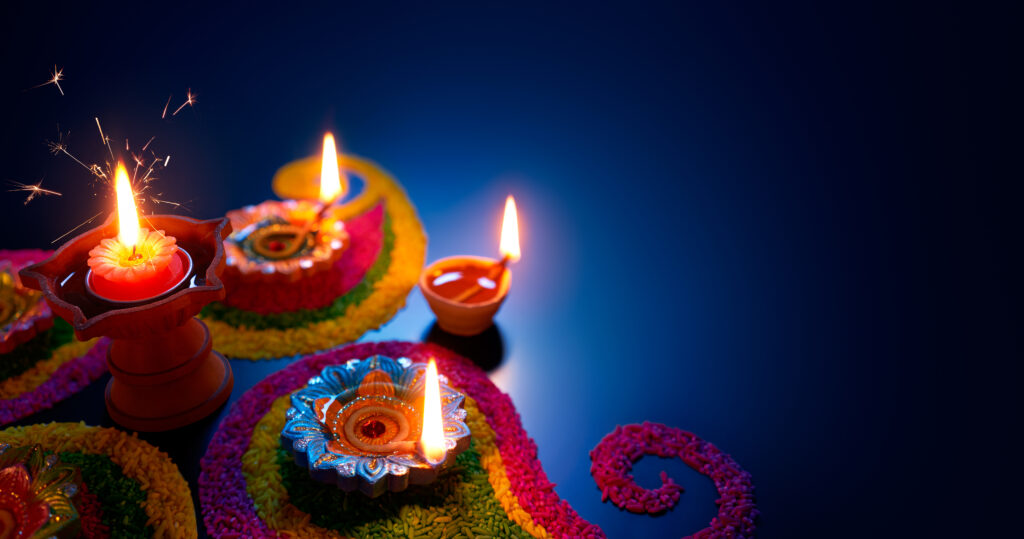
The Story of Diwali
By Jerona Duthie
Every autumn, when evenings arrive sooner and the air feels crisp with a cool breeze, India and much of the world come alive in a glow of countless lights. Balconies sparkle, streets blaze with color, and fireworks paint the night sky in thunderous bursts. This is Diwali, the Festival of Lights.
People have celebrated this auspicious holiday for more than 2,500 years. However, Diwali is more than just a holiday; it is a story told in light, music, and memory. Tradition and community come together, reminding us that light, no matter how small, always prevails over darkness.
The Origins of Light
The word Diwali comes from the Sanskrit word Deepavali, meaning “rows of lamps.” At the heart of the festival is the act of lighting small clay lamps called diyas, their golden glow filling homes, temples, and city streets.
In northern India, Diwali marks the end of Lord Rama’s 14-year exile. According to the epic Ramayana, Lord Rama and his brother, Lakshmana returned home to Ayodhya after defeating the demon king Ravana and rescuing Sita. In the spirit of communal triumph, the people of Ayodhya lit millions of diyas along their path to help guide them and welcome them home. This became a symbol of victory, loyalty, and love. Even today, lighting diyas honors that glorious homecoming.
In southern India, the festival honors another victory: Lord Krishna’s defeat of the demon Narakasura. With his fall came freedom for thousands of captives, and the day was declared one of joy and remembrance as good once again triumphed over evil.
Other stories give the festival a romantic glow. Diwali is said to mark the night Lakshmi, goddess of prosperity, chose Vishnu as her eternal partner. For Jains, it commemorates the enlightenment of Lord Mahavira. For Sikhs, it recalls Guru Hargobind Ji’s release from captivity. Each tale differs, yet all share a theme of liberation, renewal, and the triumph of light.
The Celebration
Diwali is not just remembered – it is lived. In the days leading up to the festival, families clean and decorate their homes, sweeping away old dust to make way for fresh beginnings. Many buy new clothes, exchange gifts, and prepare elaborate meals and sweets.
On Diwali night, rows of diyas glow in windows and courtyards, believed to welcome Lakshmi into the home with blessings of wealth and fortune. Fireworks erupt overhead, their brilliance scattering darkness and, in tradition, scaring away evil spirits. Neighbors exchange trays of sweets and savories, children twirl sparklers, and families gather for prayer, food, and laughter.
There is music and dancing in the streets that are strung with lights and temples humming with devotion. What began centuries ago as a symbolic welcome for heroes has become a modern ritual of connection, joy, and shared community.
A Fresh Start
Diwali is often seen as the beginning of a new year, much like the Lunar New Year in other cultures. Businesses close their books, families reconcile past quarrels, and communities extend gestures of goodwill.
For the diaspora, Diwali carries the warmth of home across oceans. From London’s Trafalgar Square to New York City’s Times Square, from Toronto to Nairobi, cities echo with light, dance, and devotion. For many, it is both a celebration and a way to stay connected to one’s heritage, no matter how far from home.
The date of Diwali shifts each year, following the Hindu lunisolar calendar. In 2025, the Festival of Lights will begin on Oct. 20. As lamps are lit across the world, they will form not just rows of light but a constellation of hope, illuminating homes and hearts alike.
A Festival of Hope
There is something quietly romantic about Diwali. A single lamp is fragile, trembling in the night breeze. But when placed among thousands, it, it becomes part of a luminous tide powerful enough to scatter the dark.
That is the essence of the festival: The belief that even the smallest light, joined with others, can guide us home. This celebration is not only about rituals or fireworks; it is about renewal, resilience, and the reminder that joy and prosperity can follow even the hardest seasons.
That is the promise of Diwali, the same promise whispered in Ayodhya centuries ago, in every home across India today, and in the hearts of all who carry a flame into the future.
Perhaps this is why Diwali has endured for millennia. Its stories may shift, its customs may vary, but its essence remains the same. It is a love letter to beginnings, to forgiveness, to the idea that no matter how heavy the shadows, light will always return. mportantly, remember this: You are the only person who can make the difference you are designed to make. Own it. Lead it. Live it.
Image: phive2015/stock.adobe.com

Leave a Reply